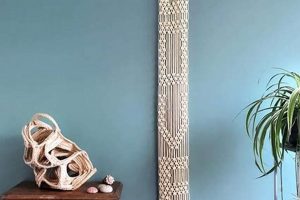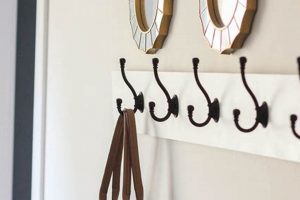A vertical garden constructed by an individual, rather than purchased pre-made or professionally installed, allows for a customized display of foliage affixed to a wall or similar vertical surface. These projects range from simple arrangements using repurposed pallets to more complex systems involving irrigation and drainage. As an example, one might use fabric pockets attached to a frame to hold soil and plants, effectively creating a living mural.
The appeal of such a botanical display lies in its ability to maximize green space in limited areas, improve air quality, and add aesthetic value to interiors or exteriors. Historically, vertical gardens have existed in various forms, from ancient hanging gardens to modern green building initiatives. This method provides a unique opportunity to connect with nature, promote well-being, and contribute to a more sustainable environment.
The following sections will explore considerations for planning, constructing, and maintaining a thriving botanical wall. Topics will include selecting appropriate plant species, choosing suitable materials, addressing watering and lighting needs, and preventing common problems associated with vertical gardening.
Construction and Maintenance Tips
Effective creation and upkeep require careful planning and consistent execution. The following guidelines address critical aspects of successful implementation.
Tip 1: Proper Planning: Thoroughly assess the intended location’s light exposure, humidity levels, and structural integrity. Account for the mature size of selected plants to prevent overcrowding. A detailed sketch or design will aid in material estimation and construction.
Tip 2: Material Selection: Choose materials resistant to moisture and degradation. Consider the weight of the system when fully saturated with water and soil. Untreated wood may require a sealant to prevent rot. Opt for non-toxic materials to avoid contaminating the soil or water supply.
Tip 3: Drainage Solutions: Implement an effective drainage system to prevent waterlogging and root rot. This may involve incorporating drainage layers, using self-watering containers, or installing a drip irrigation system with a timer.
Tip 4: Appropriate Plant Selection: Select plant species that thrive in the specific environmental conditions of the location. Consider factors such as light requirements, humidity tolerance, and growth habits. Group plants with similar needs to simplify maintenance.
Tip 5: Irrigation Management: Establish a consistent watering schedule based on the plants’ needs and the environmental conditions. Avoid overwatering, which can lead to root rot. A moisture meter can assist in determining when watering is necessary.
Tip 6: Nutrient Provision: Incorporate slow-release fertilizer or regularly supplement with liquid fertilizer to provide essential nutrients for plant growth. Follow fertilizer instructions carefully to avoid over-fertilization, which can damage plants.
Tip 7: Pest and Disease Control: Regularly inspect the system for signs of pests or diseases. Address any issues promptly using appropriate organic or chemical control methods. Prevention is key; ensure adequate air circulation and avoid overcrowding to minimize the risk of problems.
Adhering to these tips promotes a healthy and visually appealing botanical display with longevity.
The subsequent sections will delve into troubleshooting common issues and exploring advanced techniques for enhancing your botanical creation.
1. Structure
The structural component of a vertical garden is paramount, directly influencing its stability, longevity, and overall aesthetic. The support system must bear the weight of the plants, soil, and water, which can be substantial, especially when fully saturated. A poorly constructed framework risks collapse, leading to damage and potential injury. Examples include using repurposed pallets, which, if not properly reinforced and sealed, can rot and buckle under the load. Similarly, inadequate wall mounting can cause the entire structure to detach, resulting in significant damage to the wall and surrounding area. Therefore, understanding the load-bearing capacity and environmental factors is crucial during the planning phase.
The choice of materials profoundly affects the structure’s resilience. Pressure-treated lumber, metal frames, and durable plastics are often preferred for their resistance to moisture and decay. However, these materials must be carefully chosen to avoid leaching harmful chemicals into the soil, which could impact plant health. Integrating a drainage system within the structure is also essential to prevent water accumulation and subsequent structural weakening. Properly designed pockets or containers with drainage holes allow excess water to escape, preserving the integrity of the supporting framework. For instance, a modular system with interlocking planters ensures even weight distribution and minimizes stress on any single point.
In summation, the structural integrity is not merely a supporting element but a foundational requirement. Adequate design, appropriate material selection, and integrated drainage contribute to its success. Ignoring these critical factors can lead to structural failure, negating the benefits of a carefully curated vertical garden. Prioritizing structural soundness ensures the longevity and sustainability of the botanical display.
2. Irrigation
Effective hydration is critical for the sustained health and aesthetic appeal of a vertical garden. As plants are positioned vertically, natural rainfall cannot sufficiently reach all vegetation, and traditional watering methods can lead to uneven distribution and potential water wastage. Therefore, a well-designed irrigation strategy is an essential component of a thriving botanical wall.
- Manual Watering Considerations
Manual irrigation, while the simplest method, demands consistent effort and precise application. It requires evenly distributing water across all plants, ensuring saturation without overwatering, which can lead to root rot. This method is best suited for smaller systems where individual plant needs can be easily monitored. Inconsistent or inadequate watering can quickly lead to plant stress and eventual decline.
- Drip Irrigation Systems
Automated drip irrigation offers a more efficient and consistent watering solution. This system delivers water directly to the plant roots, minimizing water loss through evaporation and runoff. Timers and flow regulators can be integrated to tailor watering schedules to specific plant needs, ensuring optimal hydration without manual intervention. Careful calibration of the system is necessary to avoid over or under watering, which can damage the botanical composition. The initial investment in materials is offset by the reduced labor and improved plant health.
- Wicking Systems
Wicking systems present an alternative approach to delivering water to the plant roots. A reservoir of water is placed at the base of the installation, and absorbent wicks draw moisture up to the plant roots through capillary action. This method is particularly effective for plants with moderate water requirements and can help maintain consistent soil moisture levels. However, wicking systems are not suitable for plants with high water needs or for very large installations, as the wicking action may not be sufficient to provide adequate hydration.
- Recirculating Systems
A recirculating system minimizes water waste by collecting excess water from the drainage and recirculating it back to the plants. This system requires a pump, a reservoir, and filters to remove debris and prevent the spread of diseases. Recirculating systems are particularly suitable for larger botanical walls where water conservation is a priority. Proper maintenance of the pump and filters is essential to ensure the system’s efficiency and prevent clogs or contamination.
Choosing the most appropriate irrigation strategy is fundamental to the sustained health and visual appeal of these vertical designs. Consideration of factors such as system size, plant water requirements, and available resources is essential to ensure optimal irrigation effectiveness. An efficient watering regime contributes directly to the botanical design’s longevity and success.
3. Plant Selection
The selection of flora profoundly impacts the success and sustainability of a botanical wall. This decision dictates not only the aesthetic appeal but also the long-term viability of the installation. Incompatible species can lead to competition for resources, stunted growth, and ultimately, failure of the project. The effects of poor selection manifest as increased maintenance demands, heightened susceptibility to pests and diseases, and a diminished visual impact. For instance, incorporating sun-loving succulents in a shaded indoor environment inevitably results in etiolation, a spindly growth pattern as the plants stretch towards light. This detracts from the design and weakens the plants.
Understanding the environmental conditions of the specific location is paramount when determining appropriate species. Factors such as light intensity, humidity levels, and temperature fluctuations must be considered. Examples of successful choices include utilizing shade-tolerant ferns and mosses in low-light interiors, or drought-resistant sedums and succulents in sunny outdoor settings. Furthermore, considering the mature size and growth habits of chosen plants is essential to prevent overcrowding. Vining plants, such as pothos, can be strategically used to cascade down the wall, creating a lush, natural effect, while compact, slow-growing species are suitable for smaller pockets or containers. The practical significance of thoughtful consideration translates into reduced maintenance, enhanced longevity, and a visually striking display.
In conclusion, plant selection is a critical determinant for a thriving botanical installation. Ignoring environmental factors and growth characteristics results in compromised aesthetics and increased maintenance. Conversely, careful planning and informed choices foster a sustainable and visually captivating display. Addressing challenges related to climate and available space ensures that the resulting installation is both aesthetically pleasing and ecologically sound, connecting the design to the broader goals of sustainable living and biophilic design.
4. Lighting
Adequate illumination is a fundamental determinant of plant health and aesthetic appeal in a vertical garden. As botanical walls frequently occupy indoor spaces or areas with limited natural sunlight, supplemental lighting becomes a necessity. Insufficient light exposure inhibits photosynthesis, leading to stunted growth, pale foliage, and eventual decline. The strategic use of artificial light sources mitigates this deficiency, providing the energy required for plants to thrive. Real-world examples include indoor botanical walls incorporating full-spectrum LED grow lights to simulate natural sunlight, enabling the successful cultivation of light-demanding species. The practical significance of this understanding lies in the ability to create flourishing botanical displays in virtually any location, regardless of ambient light conditions.
Selecting appropriate lighting involves careful consideration of light intensity, spectrum, and duration. Light intensity, measured in lux or foot-candles, dictates the amount of light received by the plants. Light spectrum refers to the specific wavelengths of light emitted, with red and blue wavelengths being particularly important for photosynthesis. Duration refers to the length of time plants are exposed to light each day. Different plant species have varying light requirements, necessitating customized lighting solutions. For instance, low-light foliage such as ferns may thrive under fluorescent lamps, while flowering plants often require the higher intensity and broader spectrum of LED grow lights. In commercial settings, automated lighting systems are often employed to optimize light exposure and conserve energy. These systems adjust light intensity and duration based on ambient light levels and plant needs.
In summary, effective lighting strategies are crucial for the long-term success of botanical displays. Neglecting this factor can lead to plant decline and a diminished aesthetic experience. Conversely, thoughtful consideration of light intensity, spectrum, and duration, coupled with appropriate lighting technology, facilitates the creation of vibrant and sustainable botanical walls. Addressing lighting requirements contributes to both ecological well-being and artistic expression, ensuring that the installation remains a visually striking and environmentally beneficial addition to any space.
5. Maintenance
Sustained aesthetic appeal and biological health in a self-constructed botanical wall are directly contingent upon diligent maintenance practices. Neglecting regular upkeep precipitates a decline in visual quality and potential plant mortality. Maintenance is not an optional addendum, but rather an indispensable component integrated into the lifecycle of such a system. Infrequent watering results in dehydration and wilting, while the absence of pruning leads to uncontrolled growth that obscures the intended design. A specific instance is a neglected outdoor installation where weeds rapidly overtake desirable plants, diminishing the overall appearance and potentially impacting plant health by competing for resources.
Maintenance protocols encompass several critical areas: irrigation management, nutrient replenishment, pest and disease control, pruning, and structural inspection. Consistent watering, tailored to individual plant needs, prevents dehydration stress. The application of fertilizers, either slow-release or liquid, ensures the plants receive adequate nutrition. Regular inspection for pests and diseases allows for early intervention, minimizing the spread of infestations. Pruning maintains the desired shape and size, preventing overcrowding and promoting healthy growth. Structural integrity must be regularly assessed to address any signs of weakening or deterioration. A municipal building featuring a substantial botanical display, for example, schedules quarterly maintenance checks to ensure structural stability, pest management, and plant vitality, demonstrating the value of a well-structured maintenance program.
In summation, ongoing upkeep represents a critical determinant in the long-term viability and aesthetic success of a self-assembled botanical wall. Lack of maintenance initiates a cascade of negative consequences, culminating in plant decline and diminished visual appeal. Conversely, proactive maintenance practices ensure a thriving display, contributing to both the aesthetic and ecological benefits. Addressing challenges associated with limited time or resources necessitates creative solutions, such as implementing automated watering systems or selecting low-maintenance plant species, which ensures the ongoing care of the installation.
Frequently Asked Questions
The following questions address common concerns and misconceptions regarding the planning, construction, and maintenance of vertical gardens created by individuals.
Question 1: What is the typical lifespan of a vertical garden constructed by an individual?
The lifespan is contingent upon factors such as material selection, plant species, environmental conditions, and the diligence of maintenance practices. A well-designed and consistently maintained system can endure for several years, while neglect or poor construction can lead to premature failure.
Question 2: What is the average cost associated with building a botanical wall independently?
Costs vary widely depending on the size, materials, and complexity of the design. Repurposed materials can significantly reduce expenses. However, the investment in quality materials and irrigation systems may be necessary to ensure longevity. A detailed budget should be established prior to commencement.
Question 3: What are the most common challenges encountered during construction?
Frequently encountered issues include structural instability, inadequate drainage, improper plant selection, and difficulties with irrigation. Thorough planning and research can mitigate these challenges. Seeking advice from experienced gardeners or landscape professionals may also prove beneficial.
Question 4: What is the recommended frequency for watering a do-it-yourself botanical wall?
Watering frequency depends on plant species, environmental conditions, and the type of irrigation system employed. Regular monitoring of soil moisture levels is essential. Overwatering should be avoided, as it can lead to root rot and other plant health problems.
Question 5: What are the key considerations for pest and disease control?
Prevention is paramount. Selecting disease-resistant plant varieties, ensuring proper air circulation, and regularly inspecting for signs of infestation are crucial. Organic pest control methods are often preferred, but chemical treatments may be necessary in severe cases. Proper identification of the pest or disease is essential for effective treatment.
Question 6: What type of maintenance is generally required for these living installations?
Routine maintenance includes watering, fertilizing, pruning, and pest/disease management. Periodic structural inspections are also necessary to ensure the system remains stable and safe. The time commitment for maintenance varies depending on the size and complexity of the botanical structure.
In essence, the success of these projects hinges on meticulous planning, responsible execution, and diligent maintenance. Understanding potential challenges and proactive management are essential to achieving a lasting and aesthetically pleasing botanical display.
The following section will delve into advanced techniques for optimizing plant health and enhancing the visual impact of the constructed composition.
Conclusion
This exposition has provided a comprehensive overview of the considerations inherent in creating a “diy plant wall”. From structural integrity and irrigation strategies to plant selection, lighting, and maintenance, each element exerts a significant influence on the long-term viability and visual appeal of the finished product. A thorough understanding of these interdependencies is crucial for success.
The construction of a self-made botanical structure presents a unique opportunity to integrate nature into built environments. By embracing informed planning and consistent maintenance, individuals can contribute to environmental enrichment, enhance aesthetic spaces, and foster a deeper connection with the natural world. Continuous learning and adaptation will invariably improve outcomes and refine the practice of erecting vertical botanical displays.







